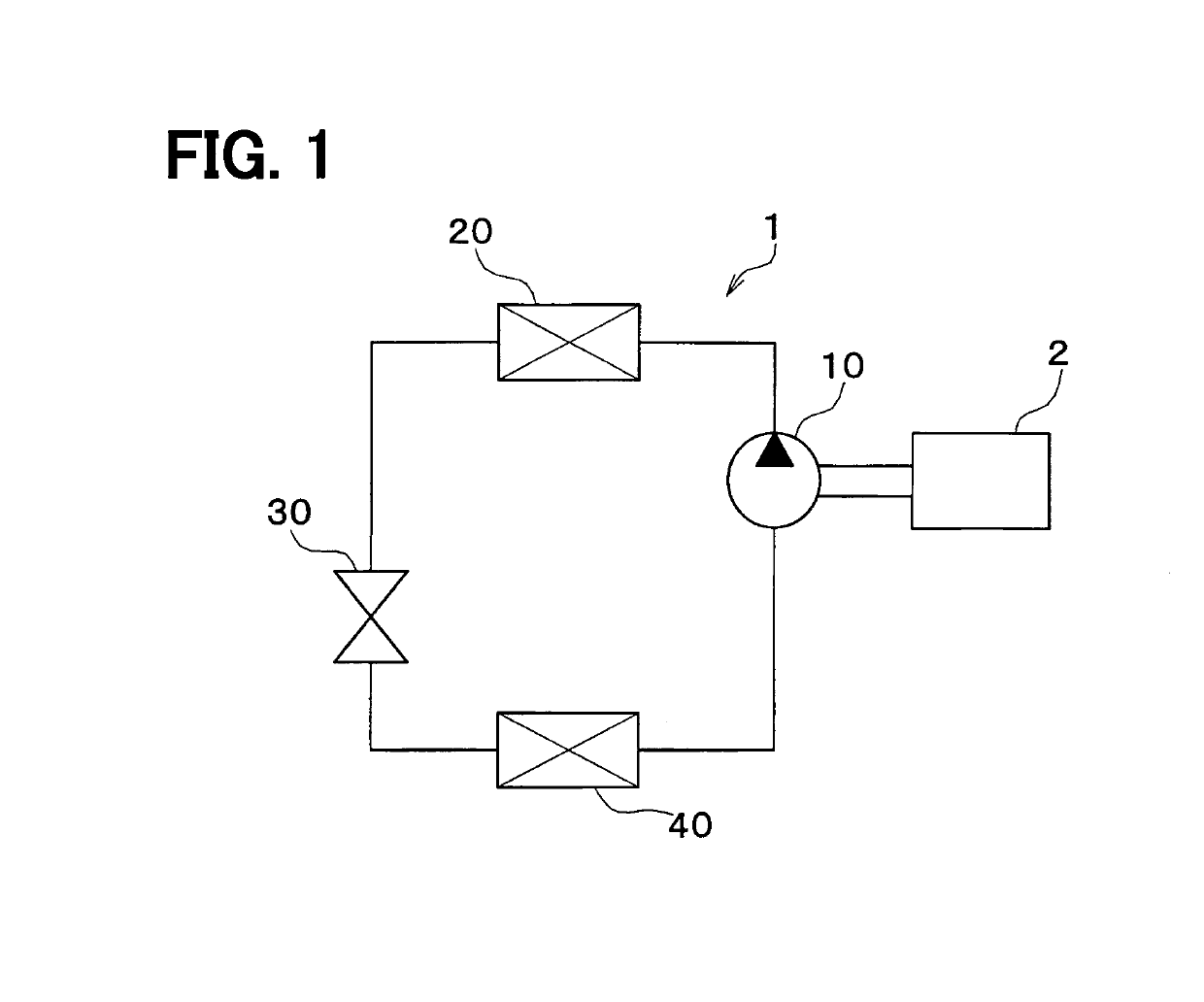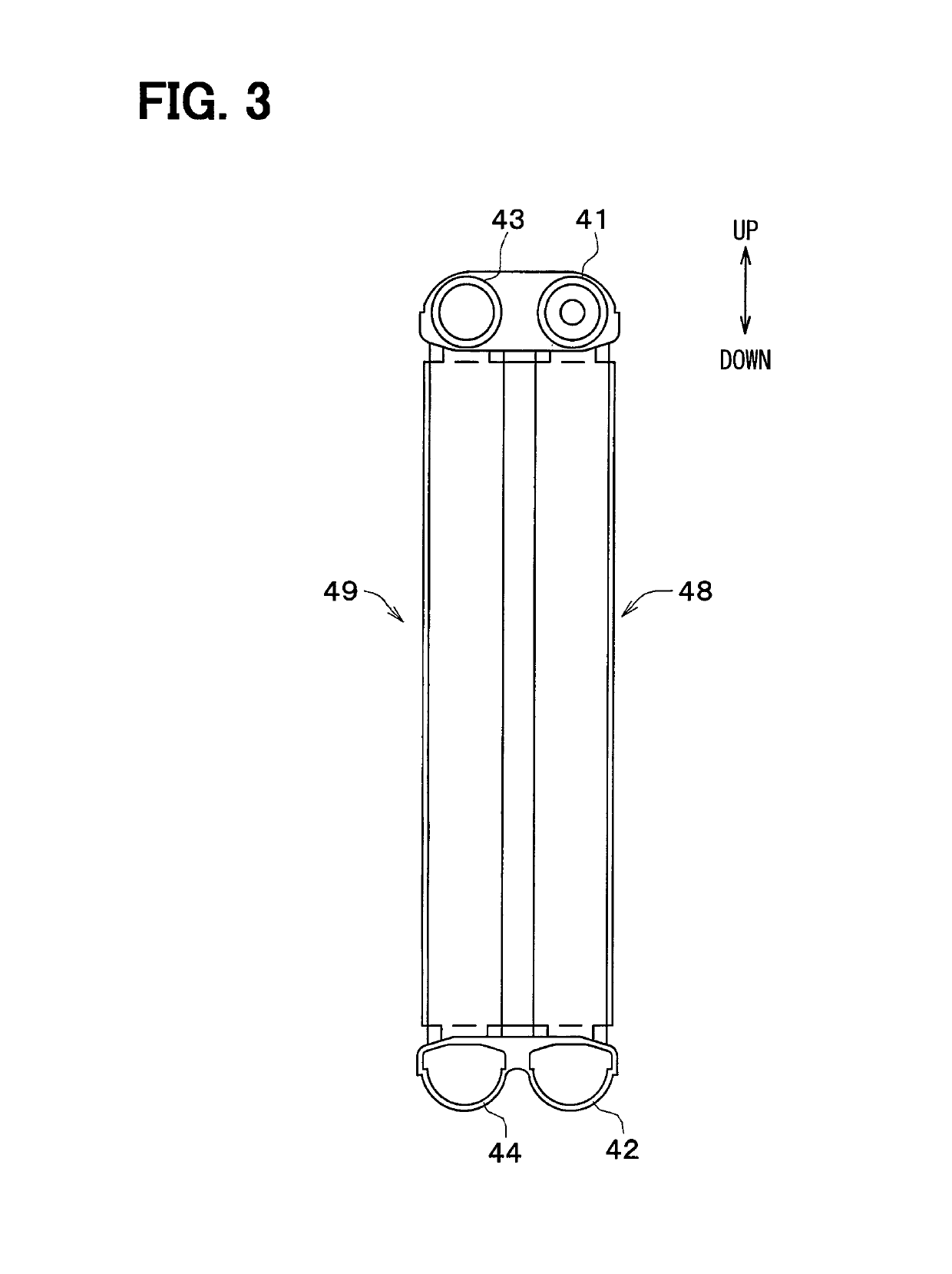Cold storage heat exchanger
a heat exchanger and cold storage technology, applied in indirect heat exchangers, refrigeration components, lighting and heating apparatus, etc., can solve the problems of difficult to flow coolant, and increasing pressure loss in the tube adjacent to the cold storage material container, so as to improve cold storage performance and facilitate cooling. flow
- Summary
- Abstract
- Description
- Claims
- Application Information
AI Technical Summary
Benefits of technology
Problems solved by technology
Method used
Image
Examples
first embodiment
[0033](First Embodiment)
[0034]The configuration of a refrigeration cycle device that constitutes a vehicular air conditioning device according to a first embodiment of the present disclosure is shown in FIG. 1. A refrigeration cycle device 1 that constitutes this air conditioning device includes a compressor 10, a radiator 20, a decompressor 30, and an evaporator 40. These components are connected in a cycle by piping, and form a cooling circulation path.
[0035]The compressor 10 is driven by a power source 2 that drives the vehicle. The power source 2 is an internal combustion engine (or electric motor, etc.). When the power source 2 stops, the compressor 10 also stops. The compressor 10 draws coolant from the evaporator 40, compresses the coolant, and then discharges the coolant to the radiator 20. The radiator 20 cools the high temperature coolant. The radiator 20 is also referred to as a condenser. The decompressor 30 decompresses the coolant which was cooled by the radiator 20. T...
second embodiment
[0067](Second Embodiment)
[0068]Next, a second embodiment of the present disclosure will be explained with reference to FIG. 6. When compared to the first embodiment described above, the present embodiment is different in that a protruding portion 52, which is described later, is disposed in the second distribution tank unit 420.
[0069]As shown in FIG. 6, the second distribution tank unit 420 respectively includes a protruding portion 52 that protrudes inward of each tank from the inner circumference surface of a wall portion 400 that forms the coolant passage in the second distribution tank unit 420. According to the present embodiment, the protruding portion 52 is disposed over the entire circumference of the each second distribution tank unit 420. Specifically, the protruding portion 52 is formed by indenting over the entire circumference of the outer circumferential surface of the wall portion 400 of the second distribution tank 420, so that the inner circumferential surface of th...
third embodiment
[0077](Third Embodiment)
[0078]Next, a third embodiment of the present disclosure will be explained with reference to FIG. 7. When compared to the above described first embodiment, the tubes 45 of the third embodiment have a different shape.
[0079]A length, in the lengthwise direction of the tubes 45, of the portion of the tubes 45 disposed inside the first to fourth distribution tank units 410, 420, 431, 440 is referred to as a protruding length. As shown in FIG. 7, the plurality of tubes 45 in communication with each of the second distribution tank unit 420 and the fourth distribution tank unit 440, which are positioned below the tubes 45 in the vertical direction, include a protruding tube 452 that has a longer protruding length than the other tubes 45. Further, FIG. 7 only shows the second distribution tank unit 420. The protruding tube 452 disposed in the fourth distribution tank unit 440 is the same as the protruding tube 452 disposed in the second distribution tank unit 420, an...
PUM
 Login to View More
Login to View More Abstract
Description
Claims
Application Information
 Login to View More
Login to View More - R&D
- Intellectual Property
- Life Sciences
- Materials
- Tech Scout
- Unparalleled Data Quality
- Higher Quality Content
- 60% Fewer Hallucinations
Browse by: Latest US Patents, China's latest patents, Technical Efficacy Thesaurus, Application Domain, Technology Topic, Popular Technical Reports.
© 2025 PatSnap. All rights reserved.Legal|Privacy policy|Modern Slavery Act Transparency Statement|Sitemap|About US| Contact US: help@patsnap.com



